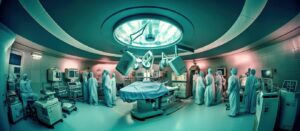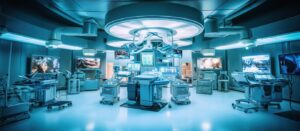Revolutionizing Surgery
The Breakthrough Role of 3D Printing in Medical Operations: Unleashing the Power of Technology to Transform Surgical Precision and Patient Outcomes
Surgery has always played a pivotal role in modern medicine, saving countless lives and restoring health to those in need. Over the years, surgical techniques have evolved significantly, driven by the desire to enhance patient outcomes and minimize risks. One such transformative innovation that has captured the imagination of surgeons and medical professionals alike is 3D printing.
This cutting-edge technology offers unprecedented opportunities to reshape the landscape of surgery, allowing for custom-made implants, precise preoperative planning, and tailored instrumentation. In this article, we will delve into the world of 3D printing in medicine, exploring its definition within the medical field and highlighting its significance in advancing surgical techniques.
Definition of 3D Printing in the Medical Field
Pioneering a New Era of Personalized Care through Additive Manufacturing
At its core, 3D printing refers to additive manufacturing, a process where objects are built layer by layer based on digital models. However, when applied to medicine, it takes on a whole new dimension.
In this context, 3D printing involves using specialized printers that can fabricate intricate three-dimensional structures using various materials such as metals, plastics, ceramics, or even living cells. By harnessing this technology’s potential for precision and customization at unprecedented levels, healthcare professionals can now create patient-specific surgical models or tailor-made implants with intricate details that precisely match an individual’s anatomy.
Importance of Surgical Advancements in Improving Patient OutcomesForging Ahead: The Pursuit of Perfection and Enhanced Quality of Life
Throughout history, surgeons have tirelessly sought ways to refine their techniques and achieve better outcomes for their patients. Advancements in surgical procedures have led to reduced operative risks, improved functional outcomes, and enhanced quality of life post-surgery. By embracing innovative technologies such as 3D printing, surgical advancements reach new heights, introducing a realm of possibilities that were once mere dreams.
The potential of 3D printing to customize surgical planning and create patient-specific implants is a game-changer in the field of surgery. It opens doors to increased accuracy, reduced operative time, minimized complications, and ultimately improved patient satisfaction.
Overview of Traditional Surgical Techniques
Limitations and Challenges Faced by Surgeons
Traditional surgical techniques have long been the cornerstone of medical interventions, allowing surgeons to treat a wide range of conditions. However, these techniques are not without their limitations and challenges.
One of the primary limitations is the reliance on two-dimensional imaging technologies, such as X-rays, CT scans, and MRIs, which do not always provide a comprehensive understanding of complex anatomical structures. Surgeons often face difficulties in visualizing critical details and spatial relationships during surgical procedures, leading to potential errors or suboptimal outcomes.
Additionally, traditional surgeries can be time-consuming and invasive, resulting in extended recovery periods for patients. These limitations highlight the need for innovative solutions that can enhance surgical precision and efficiency.

Need for Innovative Solutions to Enhance Surgical Precision and Efficiency
Given the limitations of traditional surgical techniques, there is an increasing demand for innovative solutions that can revolutionize surgery by improving both precision and efficiency. Surgeons strive to deliver better outcomes for their patients while minimizing the risks and complications associated with invasive procedures. The integration of cutting-edge technologies like 3D printing provides a promising avenue for addressing these needs.
By leveraging 3D printing technology in the medical field, surgeons can overcome the challenges posed by traditional techniques by generating highly accurate three-dimensional models that replicate patient-specific anatomical structures. This allows for detailed preoperative planning and simulation exercises that optimize surgical approaches while minimizing unexpected complications in real-life scenarios.
Furthermore, 3D printing enables customization through its ability to produce patient-specific implants and instruments tailored precisely to individual requirements. Such innovations offer immense potential to enhance surgical precision while reducing operative time and improving patient outcomes overall.
Overall, an understanding of the limitations of traditional surgical techniques highlights both the urgency and importance of seeking innovative solutions that leverage emerging technologies like 3D printing to enhance surgical precision and efficiency. By embracing these novel approaches, surgeons can navigate with confidence through complex anatomical challenges and ultimately revolutionize the field of surgery for the betterment of patient care.
The Emergence of 3D Printing in Medicine
Brief history and evolution of 3D printing technology
To understand the significant impact that 3D printing has had on the field of medicine, it is essential to delve into its fascinating history and evolution. The roots of this groundbreaking technology can be traced back to the early 1980s, when Charles Hull developed stereolithography, a method for creating solid objects by layering liquid resin that hardens under ultraviolet light. This revolutionary concept laid the foundation for what we now know as 3D printing.
Over the years, advancements in materials science, software development, and hardware capabilities have propelled this technology forward, enabling more complex and precise prints. The introduction of biocompatible materials suitable for medical use has been a critical milestone, allowing for direct application within surgical procedures.
Adoption of 3D printing in various medical disciplines
The integration of 3D printing into various medical disciplines has been swift and transformative. Its versatility allows for its adoption in multiple areas where precision and customization are paramount. In surgical fields like orthopaedics, craniofacial reconstruction, cardiovascular surgery, and neurosurgery, 3D printing serves as an invaluable tool for preoperative planning and simulation.
Surgeons can now create patient-specific anatomical models based on radiological data to gain a comprehensive understanding of unique anatomical structures before stepping into the operating room. This not only enhances surgical accuracy but also minimizes potential risks during complex procedures.
Moreover, dentistry has witnessed remarkable advancements with the use of 3D-printed dental implants, crowns, and aligners tailored specifically to individual patients’ needs. Customization extends further to prosthetics as well; amputees can now benefit from prosthetic limbs designed with intricate details that improve functionality while ensuring comfort.
Beyond surgery itself, 3D printing is also revolutionizing the production of pharmaceuticals, with personalized medication becoming a promising frontier. By precisely tailoring dosage forms to patients’ specific needs, this technology opens doors to enhanced drug efficacy and minimized side effects.
The adoption of 3D printing technology in medicine continues to expand rapidly as its potential becomes increasingly evident. The marriage of medical expertise and cutting-edge engineering has fostered remarkable progress in the field, propelling us toward a future where surgical interventions are even more precise, efficient, and patient-centred.

Applications of 3D Printing in Surgery
Preoperative Planning and Surgical Simulation
Visualizing Precision: Unveiling the Future of Surgical Planning In the realm of surgical interventions, preoperative planning plays a pivotal role in ensuring optimal outcomes. Traditional methods relying on two-dimensional images or generic anatomical models often fail to provide surgeons with an accurate representation of a patient’s unique anatomy.
Here, 3D printing stands as a game-changer. By employing this revolutionary technology, surgeons can now create patient-specific anatomical models, allowing for better visualization and understanding of complex structures.
These intricate models are crafted by converting medical imaging data into three-dimensional representations that faithfully capture the patient’s anatomy. Surgeons gain an unprecedented opportunity to examine the intricacies and complexities of an individual’s specific case before stepping foot in the operating room.
This level of precision allows for comprehensive surgical planning, taking into account various factors such as organ placement, tumour location, or vascular networks. Furthermore, virtual surgical planning takes advantage of 3D-printed models by simulating different scenarios before an actual procedure takes place.
Surgeons can virtually test different approaches and evaluate their effectiveness, identifying potential risks and optimizing their strategies accordingly. By engaging in this meticulous preoperative preparation, facilitated by 3D printing technology, surgeons can significantly enhance surgical precision while minimizing complications during complex procedures.
Customized Implants and Prosthetics
Beyond Standard Solutions: Harnessing Innovation for Personalized Care When facing intricate surgeries such as craniofacial reconstructions or limb replacements, traditional off-the-shelf implants often struggle to meet the unique needs of individual patients. However, with the advent of 3D printing technology in medicine, customized implants now offer a breakthrough solution.
For patients requiring craniofacial reconstruction due to congenital malformations or traumatic injuries, the ability to create patient-specific implants is truly transformative. Through 3D printing, surgeons can meticulously design and manufacture implants that perfectly fit the patient’s anatomy, ensuring precise alignment and functionality.
This tailored approach not only enhances the aesthetic outcome but also contributes to improved postoperative functionality and patient satisfaction. Prosthetic limbs have also experienced a significant revolution with the integration of 3D printing technology.
Traditional prosthetics often lack comfort or fail to provide users with sufficient functionality. However, by leveraging 3D printing capabilities, prosthetic limbs can now be custom-made with intricate designs that closely mimic natural anatomical structures.
This allows for a more comfortable fit and better integration into daily activities. Moreover, adjustable features enable easy modifications as patients’ needs change over time.
Surgical Instrumentation and Guides
Precision Redefined: Empowering Surgeons with Custom Tools Minimally invasive surgeries have gained prominence due to their reduced postoperative complications and faster recovery times. However, performing these delicate procedures necessitates the use of specialized tools that offer enhanced manoeuvrability and accuracy.
Enter 3D-printed surgical instrumentation. With 3D printing technology at their disposal, surgeons can now design and produce instruments tailored to specific surgical requirements.
Custom tools can be created to reach anatomically challenging areas that standard tools may struggle to access effectively. The ability to adapt instruments based on individual patient needs ensures optimized outcomes while minimizing tissue damage during complex procedures.
Additionally, patient-specific surgical guides further augment accuracy during surgeries by acting as navigational aids for surgeons. These guides are crafted using 3D printing technology in combination with preoperative imaging data such as CT scans or MRIs.
By precisely outlining target areas or providing guidance on appropriate alignment during bone resections or joint replacements, surgical guides streamline procedures while reducing errors. The applications of 3D printing in surgery are far-reaching and transformative across various domains.
From preoperative planning and surgical simulation to customized implants and prosthetics to the development of specialized tools and guides, this technology empowers surgeons to push the boundaries of precision and personalized care. As we delve deeper into the potential of 3D printing in surgery, its impact on patient outcomes will continue to revolutionize the field, paving the way for a new era of surgical excellence.
Advantages and Benefits of Using 3D Printing in Surgery
A. Improved Patient Outcomes
Reduced risk during complex surgeries
The integration of 3D printing technology into surgical procedures has significantly reduced the risks associated with complex surgeries. By facilitating the creation of highly accurate patient-specific anatomical models, surgeons can gain a comprehensive understanding of the individual patient’s unique anatomy before stepping into the operating room.
This advanced level of preoperative planning enables surgeons to anticipate potential complications, identify critical structures, and devise optimal surgical approaches. As a result, surgeries that were once considered high-risk due to anatomical complexity can now be performed with enhanced precision and reduced complications.
Enhanced precision leads to better functional outcomes
The precise customization offered by 3D printing plays a pivotal role in improving functional outcomes for patients undergoing surgery. Traditional off-the-shelf implants may not perfectly fit an individual’s unique anatomy, leading to suboptimal results or discomfort for the patient.
However, with 3D printing technology, implants can be tailor-made to match the intricate details of a patient’s anatomy. This level of customization ensures better functional outcomes as it allows for improved integration between the implant and surrounding tissues, reducing post-operative complications such as implant failure or rejection.
B. Cost-effectiveness
Reduction in operating time, anaesthesia duration, and hospital stays
In addition to enhancing patient outcomes, 3D printing in surgery also offers considerable cost-effectiveness advantages. By using preoperative planning tools that allow surgeons to practice procedures on accurate anatomical models before entering the operating room, surgical teams can optimize their workflow and reduce overall operating time.
This reduction in surgical duration translates into minimized anaesthesia exposure for patients and decreases the risk factors associated with prolonged anaesthesia administration. Moreover, by increasing surgical efficiency and precision, 3D printing helps reduce the likelihood of complications during surgery, leading to shorter hospital stays and decreased healthcare costs.
Minimization of post-operative complications
Another crucial economic advantage of 3D printing in surgery is the potential to minimize post-operative complications. By utilizing patient-specific anatomical models for preoperative planning and simulation, surgeons can identify potential challenges and adapt their approach accordingly.
This proactive approach reduces the likelihood of complications arising during or after surgery, such as injuries to adjacent structures or poor alignment of implants. Ultimately, this reduction in post-operative complications not only benefits patients by improving their recovery experience but also significantly reduces healthcare costs associated with additional treatments and prolonged hospital stays.
The integration of 3D printing technology into surgical procedures brings numerous advantages and benefits. From improved patient outcomes through reduced risks during complex surgeries to enhanced precision leading to better functional outcomes, 3D printing plays a transformative role in revolutionizing the field of surgery.
Furthermore, its cost-effectiveness is evident through a reduction in operating time, anaesthesia duration, and hospital stays, as well as minimization of post-operative complications. As this technology continues to evolve and gain wider adoption within medical practices worldwide, it holds immense promise for further advancements in surgical techniques and ultimately improving patient care on a global scale.
Challenges and Future Directions
Regulatory considerations regarding the use of biocompatible materials
As 3D printing continues to advance in the field of surgery, one of the key challenges lies in ensuring the safety and efficacy of biocompatible materials used for printing implants, prosthetics, and surgical instruments. Regulatory bodies need to establish rigorous standards for testing and certifying these materials to ensure they meet stringent biocompatibility requirements.
Additionally, long-term studies are needed to assess the durability and reliability of 3D-printed medical devices over extended periods. Collaborations among regulatory agencies, manufacturers, and researchers are vital to developing comprehensive guidelines that promote patient safety while fostering innovation.
Integration with other emerging technologies like robotics and artificial intelligence
The future of surgery lies not only in 3D printing but also in its integration with other cutting-edge technologies such as robotics and artificial intelligence (AI). Combining these innovative fields can lead to significant advancements in surgical procedures. Robotic systems can utilize patient-specific models created through 3D printing for enhanced precision and dexterity during surgeries.
AI algorithms can analyze vast amounts of patient data along with anatomical models generated by 3D printers to assist surgeons in decision-making processes during complex operations. The integration of these technologies has the potential to revolutionize surgical outcomes by improving accuracy, reducing complications, and minimizing recovery time.
Conclusion
3D printing has emerged as a revolutionary tool in the field of surgery. Its applications range from preoperative planning through customized implants to specialized instrumentation during procedures.
While there are challenges ahead related to regulatory considerations for biocompatible materials and integration with other emerging technologies like robotics and AI, it is undeniable that a future where these obstacles are overcome holds immense promise for further enhancing patient outcomes.
The combination of precision, personalization, and cost-effectiveness makes 3D printing an invaluable asset to the medical community. As research and development in this field continue to expand, we can look forward to a future where surgery becomes even more precise, efficient, and ultimately beneficial for patients around the world.






